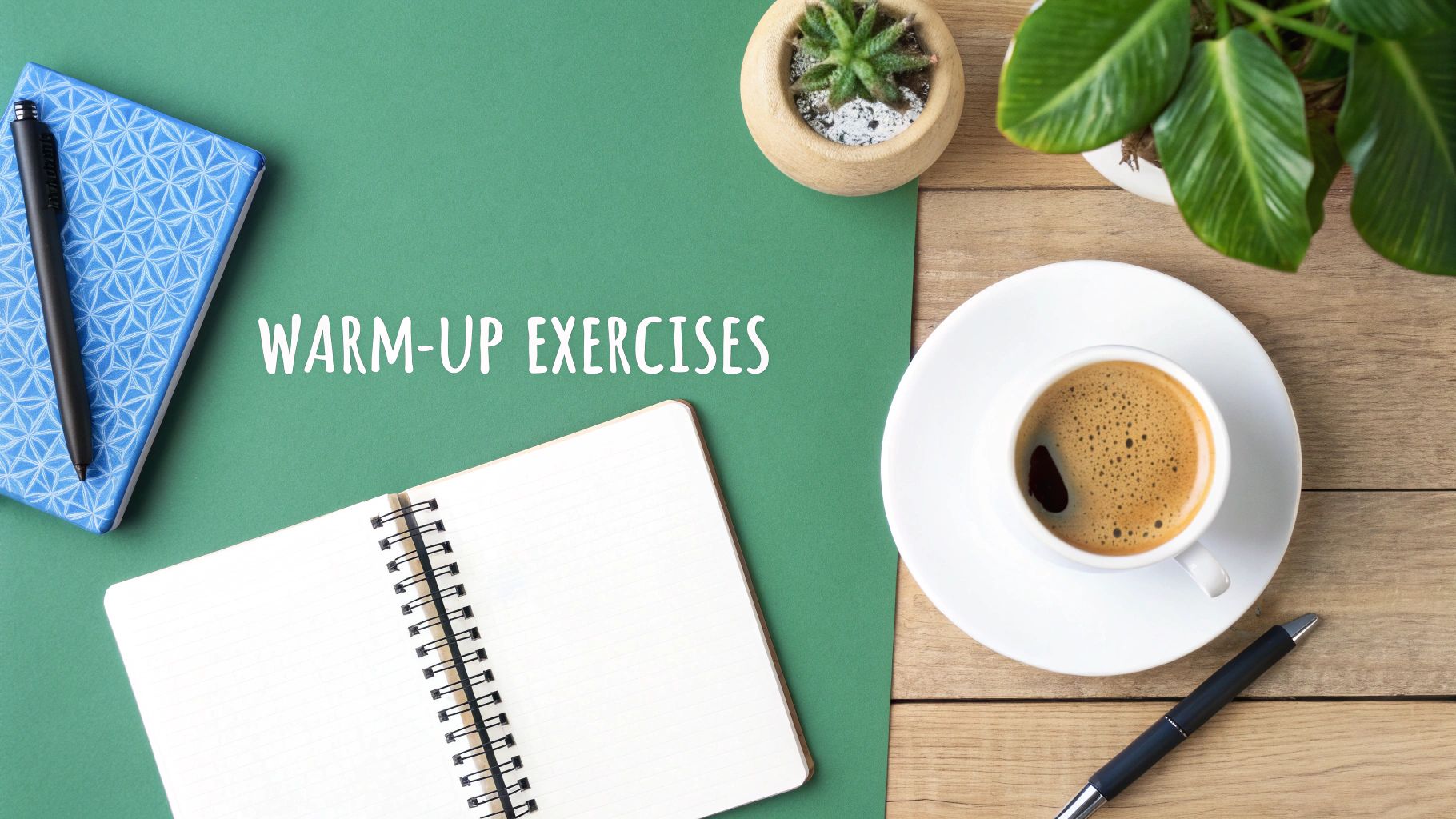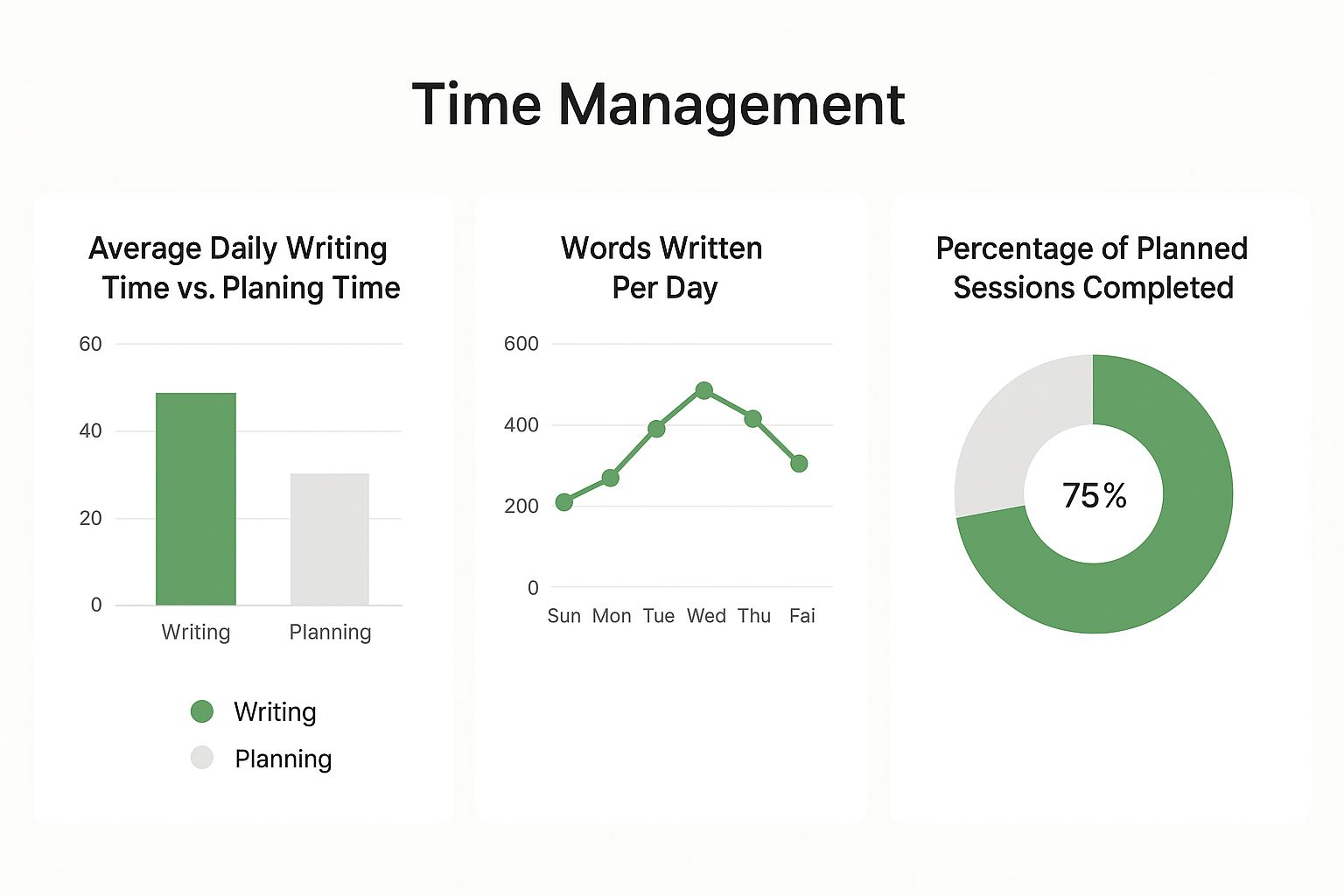
Writer's Block Help: Overcome Creative Barriers Now
June 18, 2025
Why Writer’s Block Feels So Personal and Paralyzing
We've all been there: staring at a blinking cursor that feels like it’s mocking you. It’s not just a simple case of not having ideas; it's a loud, buzzing silence filled with nagging self-doubt and rising frustration. The experience feels so personal because our writing is deeply connected to our identity and sense of worth.
When the words just won’t come, it’s easy to feel like you’ve lost a fundamental part of yourself. This is where the creative paralysis kicks in, making the simple act of opening a document feel like a monumental task. The roadblock isn't about skill; it's a crisis of confidence that brings all your momentum to a screeching halt.
The Psychology Behind the Blank Page
At its heart, writer's block is almost always fueled by fear. It's the fear of judgment—from editors, clients, readers, or our own inner critic, who is often the harshest of all. We fall into the trap of perfectionism, expecting every sentence to be flawless the moment it hits the page, an impossible standard that strangles creativity before it can even draw a breath.
This pressure is intensified because writing is an inherently vulnerable act. You’re putting your thoughts and your voice out in the world for everyone to inspect. When the fear of not being "good enough" drowns out your creative spark, the brain’s protective instincts can take over, shutting down the very process that feels so exposed. You end up in a frustrating loop of anxiety and avoidance that can feel impossible to escape.
For those whose income depends on their words, the weight is even heavier. With more than 40,000 people employed as writers in the U.S., a creative block isn't just an internal struggle; it's a financial one. The pressure to perform is immense in an industry that generated over $26 billion in revenue in a single year. This constant strain takes a toll, with one study revealing that 80% of writers reported experiencing an affective disorder. A fascinating study on writer well-being explores this connection in depth.
Recognizing Your Personal Triggers
Understanding the general psychology is a good first step, but finding effective writer's block help means figuring out what specifically triggers your block. These causes are different for everyone and can range from external deadlines to internal habits. Recognizing them is the first real step toward taking back control of your creative process.
The cause of a block can be different for everyone, and it can even change from one project to the next. Here’s a comparison of some common writer's block triggers, how often they affect writers, and how long they typically last.
| Trigger Type | Frequency (%) | Average Duration | Severity Level |
|---|---|---|---|
| Perfectionism | 75% | Days to Weeks | High |
| Creative Burnout | 50% | Weeks to Months | Severe |
| Fear of Judgment | 65% | Varies | Moderate to High |
| Lack of Clarity | 40% | Hours to Days | Low to Moderate |
Once you can put a name to your trigger—whether it’s burnout after a long project or anxiety about a new client’s feedback—you’re no longer fighting a vague, intimidating monster. Instead, you have a specific problem to solve. This self-awareness is a game-changer. It shifts your mindset from a defeated "I can't write" to a proactive "I'm struggling to write because..." and that "because" is where you find your power again.
Rewiring Your Creative Mindset for Consistent Flow

Knowing what causes your writer's block is a huge step, but the real, long-term fix comes from rewiring how you approach writing itself. The most productive writers aren't magically immune to resistance; they’ve just built a stronger mental toolkit to push through it. This means shifting your perspective from one of fear and pressure to one of genuine curiosity.
It's less about a quick fix and more about building creative endurance. This mental battle is far from new. The term 'writer's block' was actually created by psychoanalyst Edmund Bergler in the 1940s. He studied under Freud and was convinced he had the solution, yet here we are still wrestling with the same blank page. This proves that the answer lies in our mindset, not a secret formula. You can dive deeper into the history of writer's block and its origins here/02:Bad_Ideas_About_Who_Good_Writers_are.../2.09:_Writers_Block_Just_Happens_to_People).
Taming Your Inner Critic
We all have that nagging voice in our heads, the one that insists our work isn't good enough before we’ve even finished a sentence. This inner critic feeds on perfectionism and can stop you in your tracks. The trick isn't to silence it—that’s nearly impossible—but to change your relationship with it.
When that voice pipes up, acknowledge it. You can even thank it for trying to keep you safe from failure, then politely inform it that you're going to write anyway. This simple mental move helps separate your sense of self-worth from the quality of a first draft. A great way to start is by setting a ridiculously small goal, like writing for just 15 minutes or putting down 100 words of pure nonsense. The objective isn't quality; it's momentum.
Embracing Imperfect Action
The idea of a perfect first draft is one of the most damaging myths for a writer. You have to grant yourself permission to be messy. Author Anne Lamott famously wrote about the "shitty first draft" because the concept is so liberating. When you lower the stakes, your brain is free to play, explore ideas, and find connections you never would have seen otherwise.
To put this into action, try these exercises:
- Challenge yourself to write without using the backspace key. The goal is just to get the words out, no matter how awkward or clunky they sound. Editing is a completely different task for another time.
- Pinpoint your core message. What is the single most important thing you want to communicate? Write that one sentence down first. Everything else can be built around it.
- Build trust in your process. This approach is a skill that gets stronger with use. The more you show up and create imperfect work, the more you’ll believe in your ability to get it done. Learn more in our article about how to improve writing through steady practice.
Creating Spaces That Naturally Inspire Writing
 Sometimes, the best writer's block help isn’t found in your head but in the room you're sitting in. Your surroundings have a huge effect on your mood and ability to concentrate; a boring space can easily lead to boring ideas. Many writers talk about the "coffee shop effect"—that sudden burst of productivity that comes from a simple change of scenery. This isn't magic, it's just psychology at work. By being intentional about your spaces, you can create an atmosphere that helps words flow instead of feeling forced.
Sometimes, the best writer's block help isn’t found in your head but in the room you're sitting in. Your surroundings have a huge effect on your mood and ability to concentrate; a boring space can easily lead to boring ideas. Many writers talk about the "coffee shop effect"—that sudden burst of productivity that comes from a simple change of scenery. This isn't magic, it's just psychology at work. By being intentional about your spaces, you can create an atmosphere that helps words flow instead of feeling forced.
Designing for Deep Focus
Your primary writing area should be a sanctuary for concentration, not a cluttered catch-all for distractions. Even small adjustments can make a world of difference. Take a moment to consider your sensory inputs: Is the light from your lamp too harsh? Is your chair secretly making your back ache? These little irritations are constantly chipping away at your focus. The goal is to create a space where the path of least resistance leads directly to your keyboard.
- Lighting: If possible, place your desk where it gets natural light. If you're stuck in a darker corner, a lamp that mimics daylight can seriously reduce eye strain and lift your mood.
- Sound: Some of us need complete silence, while others thrive on ambient noise. Play around with white noise apps, instrumental music, or invest in a quality pair of noise-canceling headphones to find your sweet spot.
- Tools: Keep your essentials—your favorite pen, a specific notebook, a glass of water—within arm’s reach. This prevents you from breaking a creative spell just because you had to get up and look for something.
This concept of being completely immersed in an activity is what's known as a flow state), a psychological term for being fully "in the zone." The key to achieving it is balancing the challenge of a task with your personal skill level.

As the idea illustrates, your environment is crucial for getting rid of the distractions that prevent you from reaching this state of deep focus.
The Power of Novelty and Rotation
Even the most perfect writing space can start to feel uninspiring if you never leave it. This is where a little novelty becomes your best friend. Regularly changing your writing location—moving from your home office to the kitchen table, or from the kitchen table to a local library—can be enough to jolt you out of a creative rut. A new environment offers fresh sensory details that can trigger new connections and ideas.
The strategy here isn't about hunting for one perfect writing spot. It's about building a small collection of them. By having two or three reliable go-to spaces, you can strategically rotate between them to keep your mind engaged and your perspective fresh. This rotation becomes a powerful, proactive tool for writer's block help, ensuring you always have a fresh start waiting just a few steps away.
Proven Techniques That Get Your Fingers Moving
Even with the perfect writing setup, we've all been there: staring at a blinking cursor on a blank page, feeling completely stuck. When you find yourself in that cycle of overthinking, you need a practical way to get past your own internal critic. The aim isn't to write a perfect draft on the first try; it's just about getting words on the page to build some momentum.
Try Timed Writing Sprints
One of the most reliable ways to break through resistance is using an approach like the Pomodoro Technique. It's simple: you set a timer for a short burst of time—25 minutes is a great starting point—and you just write. There are no other rules. You don't get to edit, you don't get to backtrack, and you certainly don't get to judge what you're writing.
This small constraint tricks your brain into focusing only on the task at hand, not the massive project looming over you. By breaking it down into manageable chunks, the work feels less intimidating. Visualizing your writing habits can also show you where your time is really going.

Looking at data like this often shows that consistent, short sessions produce far more than one long, grueling attempt that just leads to burnout. When the timer rings, step away for a few minutes. Do this a couple of times, and you might be surprised by how much you’ve actually accomplished.
Capture Ideas With Your Voice
Sometimes, the keyboard itself is the source of the pressure. If you're frozen in front of the screen, put your laptop aside and pull out your phone. Open the voice recorder app and start talking through your ideas as if you were explaining them to a friend over coffee. You can do this while pacing your room, doing the dishes, or going for a walk.
The goal is to get your thoughts out in a natural, unfiltered way. Speaking often feels less formal than writing, which helps you sidestep perfectionism. Here are a few things you can try:
- Talk through your main points: Verbally map out the structure of your piece, from the introduction to the conclusion.
- Explain your concept to an imaginary audience: This forces you to simplify your message and find the core of what you're trying to say.
- Record a free-form brainstorm: Just let your ideas flow without worrying about structure or order.
After you're done, you can use a transcription tool or just listen back and type out the valuable parts. You’ll often find you’ve already laid a great foundation. To help you choose an approach, the table below compares these quick-start methods.
| Technique | Time Required | Best For | Effectiveness Rating |
|---|---|---|---|
| Pomodoro Technique | 25-minute intervals | Overcoming the initial fear of the blank page and building quick momentum. | Very High |
| Voice Memo Brainstorming | 5-15 minutes | Unlocking ideas when typing feels too formal or when you need to find your natural voice. | High |
As you can see, both of these methods for writer's block help require very little time but are highly effective at getting you moving again.
These small, consistent actions are what build strong writing habits. If you're looking for more ways to build good practices, our guide on how to improve your writing skills over time is a great next step.
Using AI Tools as Creative Collaboration Partners
When you’re stuck, the idea of turning to AI for writer's block help can feel like admitting defeat. But what if you viewed these tools as a creative collaborator instead of a ghostwriter? The trick is using them to spark ideas and build momentum, not to write the entire piece for you. This way, your authentic voice stays in the driver's seat while you get the push needed to clear that creative hurdle.
Brainstorming Without the Pressure
We've all been there, staring at a blinking cursor on a blank page that seems to demand a brilliant idea on the spot. AI can take that pressure off by acting as an endless brainstorming partner. Instead of asking it to write a full article, give it creative prompts that force it to think alongside you. This changes the dynamic from generation to collaboration, which is a lot less intimidating when you're feeling blocked.
Next time you’re stuck, try feeding it prompts like these:
- Act as a curious reader and ask me five challenging questions about my topic: [your topic].
- Generate ten different metaphors I could use to explain the concept of [your complex idea].
- List three unconventional angles for a blog post about [your subject].
From Rough Ideas to a Usable Draft
Once you've got a few raw ideas, an AI can help you shape them into a coherent structure. You can paste in your jumbled brainstorming notes and ask for a logical outline. This process turns a chaotic cloud of thoughts into a clear roadmap, giving you a solid starting point for your first draft.
From there, you can concentrate on polishing the text. For example, tools like Natural Write are designed specifically to help refine those initial drafts, whether they came from your own frantic sprint or an AI-assisted brainstorm.

This shows how you can take robotic or clunky text and quickly humanize it, allowing you to focus on the core message while the tool refines the language to sound clear and authentic. Once your draft feels more like you, you can dive deeper into making it powerful. You can explore more ideas by checking out our guide on how to write compelling content.
This process isn't about letting a machine do the work; it’s about using technology to clear the path. By treating AI as a partner for the grunt work of outlining and initial phrasing, you preserve your mental energy for the most important part: infusing the piece with your unique perspective and creativity. You remain the author and director of the project—you’re just using a new tool to overcome resistance and get back to writing.
Building Your Anti-Block Writing System
Getting past a creative slump feels great, but what if you didn't have to fight that battle nearly as often? The best writer's block help isn't a single trick you pull out during a crisis. It's the system you build to keep the crisis from happening in the first place. This is about creating a set of habits that keep your creative gears turning, turning writing from a source of anxiety into a reliable professional skill.
Treat Writing Like a Routine, Not a Muse
Let's be honest: waiting for the "muse" to show up is one of the most common ways to end up with a blank page. Truly productive writers don't sit around hoping for inspiration to strike; they build a routine they can depend on. It’s a lot like exercise. You don't just go to the gym when you feel motivated—you go because it's part of your schedule.
When you commit to a dedicated, non-negotiable time for writing, you train your brain to be ready to create on command. This doesn't have to be a monumental task.
- Start small: Even 20-30 minutes a day is enough to build the habit.
- Be consistent: Try to write at the same time every day. This creates a powerful mental cue that it’s time to get to work.
- Focus on the act, not the outcome: The initial goal isn't to write a masterpiece. It's simply to show up and put words on the page, reinforcing the habit.
This consistency creates a momentum that will carry you through the days when you feel completely uninspired.
Create Gentle Accountability
While the pressure of a hard deadline can sometimes cause writer’s block, a bit of gentle accountability can be a fantastic motivator. The trick is to find a system that feels supportive rather than stressful. You need an external reason to show up that doesn’t rely on your own fluctuating willpower.
Find a writing partner, for instance. You don't even have to read each other's work. Just agree to send a quick text each day asking, "Did you write?" You’d be surprised how effective that simple check-in can be. Another great method is to get a big wall calendar and draw a giant 'X' over every day you write. As the chain of X's grows, you’ll find you don't want to break it. This makes the process a game rather than a chore.
Plan Your Recovery Before You Need It
Even with the most solid system, off-days are inevitable. The key is to have a recovery plan in place so that a minor setback doesn't snowball into a full-blown block. Get to know your personal warning signs. For me, it’s when I start obsessively reorganizing my desktop icons or suddenly feel an intense urge to alphabetize my spice rack.
When you notice your own avoidance tactics, it's time to pivot to a pre-planned activity. Keep a list of low-pressure writing-adjacent tasks ready to go:
- Work on a different, more fun project for an hour.
- Go for a walk without your phone.
- Do a 10-minute freewrite about something totally unrelated and silly.
Knowing you just need to get a rough draft down is also a huge relief. When you're pushing through and the words feel awkward, you can rely on a tool like Natural Write to help humanize the text later. This lowers the stakes of that first draft, making it much easier to stay in the flow and just get your ideas out. Building this system provides the durable structure creativity needs to thrive long-term.
Your Personalized Writer's Block Recovery Strategy
There’s no magic pill for writer's block because every writer’s creative friction is personal. The most effective writer's block help comes from a strategy built just for you. It’s not about finding a single fix, but about assembling a custom toolkit that matches your specific challenges, work style, and creative goals.
Ask the Right Questions to Find Your Block’s Source
To figure out your personal plan, you need to become a detective of your own creative process. When you feel that familiar resistance creeping in, stop and ask a few diagnostic questions. Is this block really about the writing, or is it fear of a client’s feedback? Are you physically drained from a long week?
Maybe the project’s scope feels like a tangled mess, or you’re just putting way too much pressure on yourself to write a perfect first draft. Answering these questions honestly helps you uncover the real problem. A block caused by burnout needs a completely different fix (like rest) than one born from a lack of clarity (which might need more outlining).
Build Your Emergency Protocol
Once you start recognizing your common triggers, you can build your own rapid-response plan. Think of this as your "in case of emergency, break glass" list of actions for when a block hits hard. The trick is to match your personal triggers to the right techniques.
- If you’re a perfectionist: Your go-to move could be a 15-minute freewriting sprint where the backspace key is off-limits.
- If you feel burned out: Your protocol is to step away from the keyboard entirely for a walk or to switch gears to a low-stakes personal project.
- If the topic feels overwhelming: Your plan might be to grab your phone and talk through your ideas into a voice memo, just to find a simpler way in.
This personalized approach turns a creative crisis into a solvable problem. A key part of that protocol should be having a reliable tool that takes the pressure off producing a flawless first draft. When you know you can get ideas down—no matter how messy—and refine them later, the fear of the blank page starts to lose its power.
Ready to build a writing system that actually works for you? Try Natural Write for free and see how easy it is to humanize any draft, letting you focus on your creativity, not on perfection.


